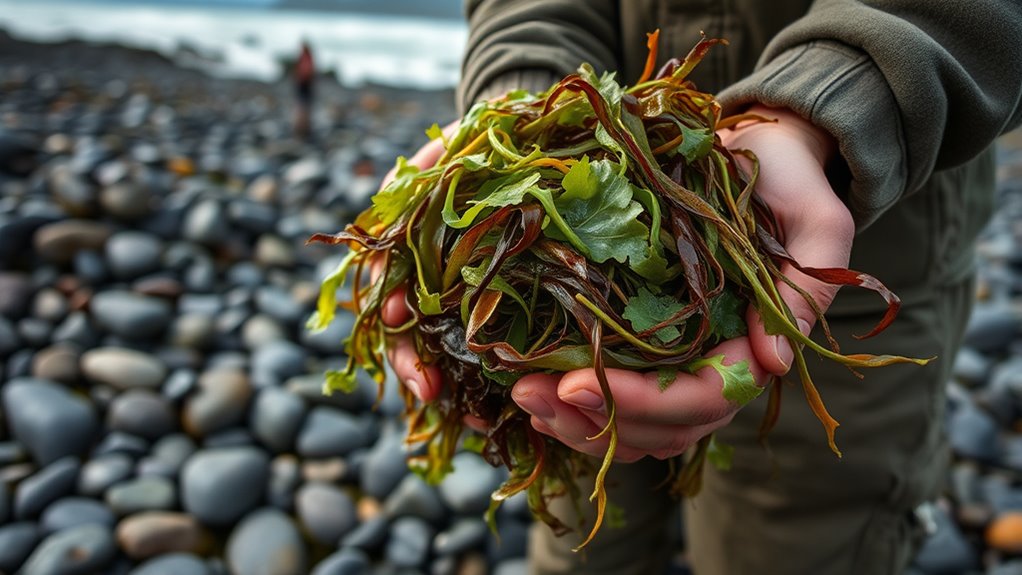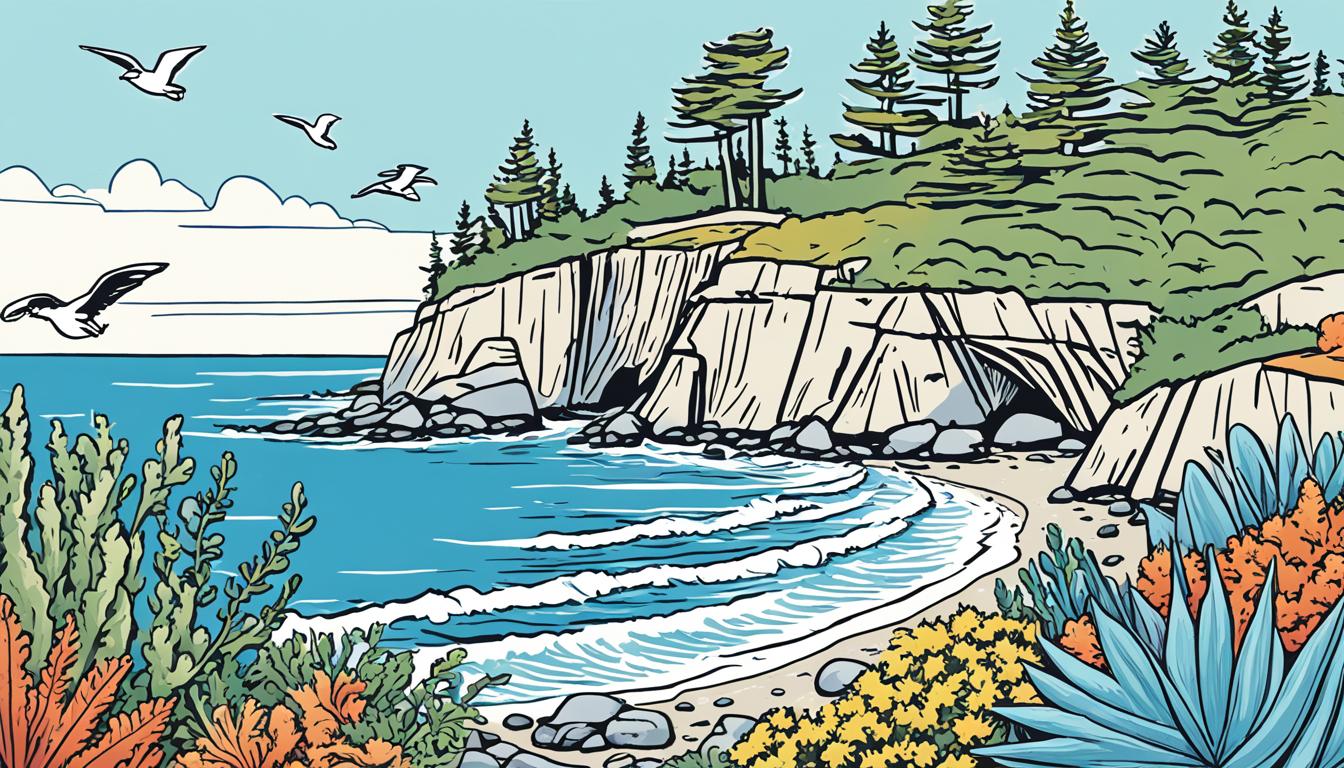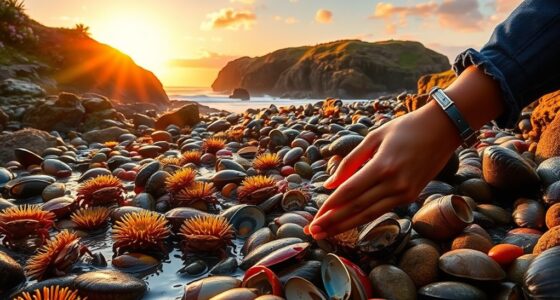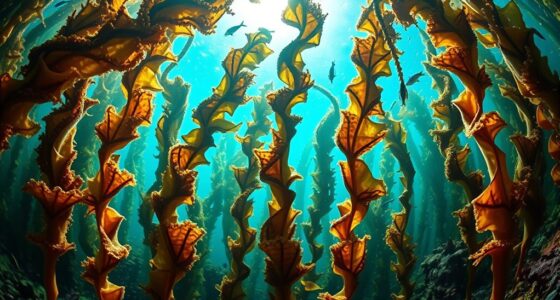To foraging sea vegetables for winter, focus on harvesting responsibly from healthy, unpolluted waters during low tide, using scissors to cut plants at their base and leaving plenty behind. Proper preparation includes rinsing thoroughly and drying or freezing for later use. These nutrient-rich foods support your health and help sustain coastal ecosystems for future foragers. Keep exploring, and you’ll discover more tips to harvest sustainably and enjoy these essential ocean treasures year-round.
Key Takeaways
- Harvest during low tide from healthy, unpolluted waters using scissors to cut at the base, ensuring regrowth.
- Select abundant, safe sea vegetable varieties and avoid overharvesting to promote ecosystem health.
- Rinse thoroughly to remove sand and salt, then dry or freeze for winter consumption.
- Practice sustainable harvesting by leaving plenty of plants behind and avoiding heavily trafficked areas.
- Connect with nature through responsible foraging, supporting future access and coastal ecosystem protection.

Foraging sea vegetables is an exciting way to connect with nature while gathering nutritious, sustainable food. As you venture into coastal waters, it’s crucial to practice sustainable harvesting to guarantee these essential plants continue thriving. By harvesting responsibly—avoiding over-collecting, leaving plenty behind, and steering clear of heavily trafficked areas—you help protect delicate ecosystems and promote their ongoing health. Sustainable harvesting means you pick only what you need, take from healthy populations, and leave enough for regeneration. This approach ensures that future foragers can enjoy these nutrient-rich plants too, creating a cycle of nourishment that benefits everyone involved.
Practice sustainable harvesting to protect coastal ecosystems and ensure future access to nutritious sea vegetables.
When it comes to the nutritional benefits of sea vegetables, you’re tapping into a treasure trove of key vitamins, minerals, and antioxidants. Sea vegetables like kelp, nori, dulse, and wakame are packed with iodine, which supports thyroid health, and calcium, magnesium, and iron that bolster bones and blood health. They’re also rich in vitamins A, C, E, and K, offering immune support and skin benefits. Because they grow in mineral-rich waters, these plants absorb nutrients directly from the ocean, making their nutritional profile far superior to many land vegetables. Incorporating them into your diet can boost your overall health, enhance digestion, and provide long-lasting energy.
To gather sea vegetables properly, start by identifying safe, edible varieties. Look for plants that are free from pollution, oils, or other contaminants—these tend to be found in clean, unpolluted waters. Use scissors or knives to cut the plants at their base, avoiding excessive removal, and always leave enough behind to allow for regrowth. Harvest during low tide, when the plants are most accessible and in their prime condition. Remember, handling these plants gently preserves their delicate structure, making them easier to clean and prepare later.
After harvesting, rinse the sea vegetables thoroughly with fresh water to remove sand, salt, and any debris. Proper cleaning ensures you enjoy their full nutritional benefits without any gritty residue. Once cleaned, you can dry them for future use or incorporate them directly into soups, salads, or sushi. Freezing some for later ensures you have a steady supply of these nutritious greens, especially during winter months when fresh options are limited. Foraging sea vegetables not only provides you with a fresh, sustainable food source but also deepens your connection to the ocean and its ecosystems. By respecting sustainable harvesting practices and understanding their nutritional value, you make your foraging both responsible and rewarding.
Frequently Asked Questions
Are Sea Vegetables Safe for People With Shellfish Allergies?
Sea vegetables can be risky if you have shellfish allergies because they may be contaminated through harvesting techniques, especially if collected near shellfish beds. While seaweed nutrition offers many benefits, always check labels or source from trusted suppliers. To stay safe, avoid wild foraging unless you’re certain about harvesting techniques and contamination risks. Consulting with an allergist before trying new sea vegetables is also highly recommended.
How Do I Identify Edible Versus Toxic Sea Vegetables?
To identify edible versus toxic sea vegetables, you should look for clear identification tips such as color, shape, and texture, and avoid any that show signs of algal toxicity like discoloration, sliminess, or unusual odors. Stick to well-known, safe species like nori or wakame, and cross-reference with reliable guides. When in doubt, consult an expert to prevent harvesting toxic varieties, ensuring your foraging is both safe and enjoyable.
What Equipment Is Essential for Sustainable Foraging?
Think of your foraging journey as a well-tuned symphony; your essential equipment sets the rhythm. You’ll need sturdy harvesting gear like scissors or knives to gently harvest sea vegetables without damage. A mesh bag helps with safe collection, while preservation methods like rinsing and drying guarantee freshness. Don’t forget gloves to protect your hands from the salty embrace and a guidebook to identify your bounty, ensuring sustainable, respectful foraging every time.
Can Foraged Sea Vegetables Be Stored Long-Term?
Yes, you can store foraged sea vegetables long-term. To do this, focus on seaweed preservation through proper storage techniques like drying, freezing, or pickling. Drying seaweed in a well-ventilated area preserves its nutrients and flavor, while freezing retains its freshness for months. Pickling adds a tangy flavor and extends shelf life. make certain your storage containers are airtight to prevent moisture and maintain quality.
Are There Legal Restrictions on Sea Vegetable Harvesting?
Yes, you need to check regional regulations before harvesting sea vegetables. Some areas require harvesting permits, especially if you’re collecting large quantities or targeting protected species. Always research local laws to avoid fines or confiscation. Regulations vary by region, so contacting local authorities or marine agencies guarantees you’re compliant. Following these guidelines helps preserve marine ecosystems and supports sustainable foraging practices.
Conclusion
As you gather sea vegetables this winter, remember that over 70% of the world’s population relies on wild-foraged foods like seaweeds for their nutrition. By foraging responsibly, you not only enjoy fresh, nutrient-rich foods but also support sustainable practices that protect ocean ecosystems. Embrace this seasonal bounty, knowing you’re part of a global tradition that nourishes communities and promotes environmental stewardship. Happy foraging—your efforts make a meaningful difference!









